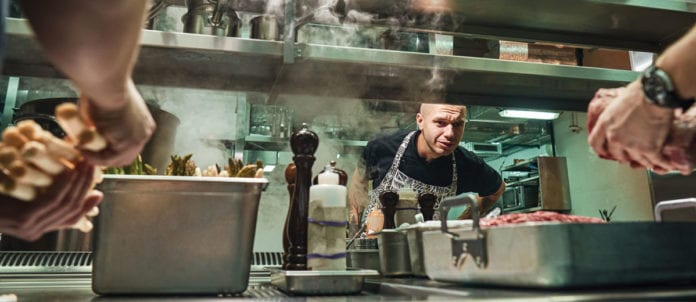THE CHALLENGE
The road from farm to fork is a long one, with food passing through many hands before landing on customers’ plates. And when food is travelling along the supply chain, safety is top-of-mind at every touch point.
Billy Arvanitis, vice-president of Operations at Montreal-based Foodtastic, says food doesn’t make it into his restaurants unless it’s passed safety tests at every step.
“[Food safety] is paramount. Where you’re sourcing products from a supplier, the companies they partner with have to be federally licensed and inspected by a reputable corporation. The safety of the product when it comes in is first and foremost,” says Arvanitis. “I know there’s a lot that goes into running a restaurant, but it all starts there.”
Ensuring restaurant food is safe is a lengthy and meticulous process, but as Domenic Pedulla, president of the Calgary-based Canadian Food Safety Group says, it’s a
necessary one.
“Not meeting safety standards could be devastating to your business; it could sink a lot of small businesses,” says Pedulla.
While the logistics behind keeping food safe varies at every level — from supplier to restaurant operator — the one constant is training.
Ruth Pertran, Ph.D. is a senior corporate scientist of Food Safety and Public Health at Ecolab and in her experience, it’s about the people, not the equipment.
“Food safety is all about behaviours performed by everyone along the food supply chain, from farm to fork,” says Pertran.
This need for intense attention to detail at every step is compounded by the fact food is being shipped from companies scattered across the globe, she adds.
“Today’s long, globalized food supply chain creates many opportunities for food to become contaminated. And large-scale production and distribution can lead to broad infection, potentially affecting foods served at your restaurant.”
Experts agree training is the best way to mitigate most, if any, food-safety concerns at any facility. Whether in the distribution warehouse or the restaurant kitchen, it all comes down to staff.
However, this can cause problems, as staff training can be costly, with Pedulla saying services can cost up to $100 per staff member.
This puts a crunch on many small businesses, forcing them to cut corners in some situations — something Pedulla knows hangs over the industry like a dark cloud.
“Money is a barrier for a lot of companies since margins are notoriously thin in foodservice. It’s a barrier to the smaller businesses that have to do it on their own.”
Arvanitis sees the choice as an easier one — money is only a problem if you make it one.
“It’s pretty easy. A lot of the [practices] that truly help keep your guests safe don’t cost very much. It just takes discipline to follow procedures put in place,” says Arvanitis. “Equipment comes into play eventually, but training and tools come into play first.”
“Smart” equipment has become trendy in the industry, with some larger, more financially capable companies opting for the newest technology but, according to Arvanitis, the best solution to the problem — with a few exceptions — is training the people who operate the equipment, not replacing the equipment.
“There are exceptions where foodservice equipment is not up to par or not working, but most of the time the things that help keep you safe are about the discipline of the staff,” says Arvanitis. “You hope everybody follows suit, but when there’s proper training in place, it become automatic.”
The challenges associated with food safety extend beyond equipment and training costs. For those who don’t meet the standards put in place across the country, an intangible penalty is laid down — and it could be harsher than any fine.
“There’s no question, we won’t talk to somebody that has a questionable reputation for food safety — that would be completely illogical. We want to partner up with reputable companies so we have traceability,”
“For companies focused on food safety, protecting their reputations and reducing the risk of losing customers is how they capitalize on the issue. Ensuring they’re protecting customers from foodborne illnesses or food contamination is critical to staying in business, building their reputation and maintaining repeat customers,” adds Pertran.
THE OPPORTUNITY
On one side of the proverbial food-safety coin is staff training and habits, which are at the forefront of food safety in the restaurant industry. And with more certification programs available, restaurant operators have a chance to stand out from the crowd by going above and beyond the call of duty.
Ontario recently passed a law mandating restaurants have at least one person on each shift who is safe-food-handling certified. Pedulla’s company does training for these certificates and, while he says it’s a step in the right direction, he doesn’t believe it’s enough.
“That doesn’t seem high enough, right? We want to make training affordable for everyone, not just managers and supervisors.”
The Canadian Food Safety Group is addressing the gap by offering certification at a lower cost. High-school students can become fully certified for just $15 and other members of the industry pay only $25.
“We don’t make a lot of money at this, but it’s not about that — what’s important is that it’s accessible for everyone,” says Pedulla.
The other side of the coin is equipment and technology and how operators incorporate innovation into their operations to promote a healthier, safer foodservice industry.
Practices as simple as having a hygienic design on meat processors, which allows for employees to easily dismantle and clean the machine without using extra tools, or installing an automatic door bottom — a rodent-proof auto-retracting door bottom to keep pests out — will help eliminate problems. More intricate equipment offerings include the Steam Infusion Vaction Pump, a device that sits within a cooking vessel and uses steam to simultaneously heat, mix and pump liquids without particulates, or the HFPC 120 robotic food-handling system, which uses a modular approach to match the requirements of operators’ food-processing line.
While efficient equipment can help operators save money and time and training can help stave off bad habits in employees, food safety in and of itself is non-negotiable.
“As a restaurant owner or manager, preventing foodborne illnesses is perhaps your most serious responsibility. Not only is it important to your customers’ safety and satisfaction, it’s critical to your business,” says Pertran. “The many federal and provincial regulations aimed at protecting consumers from tainted foods can be used to hold restaurateurs strictly liable for serving contaminated foods that make someone sick. Failure to take food safety seriously can result in negative publicity, expensive lawsuits and, in some cases, criminal charges.”

















